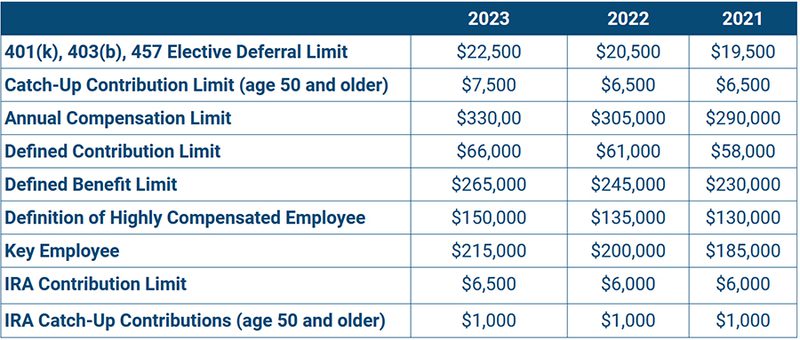
Here are the latest plan contribution and benefit limits. Read all the detailed notes that describe what has been changed or updated for Plan contributions.
McKinley Carter wants to make sure you have the necessary tools and capabilities for your business. Our team is dedicated in helping you succeed. That's why we are here to ensure you are promptly notified with the latest plan contribution and benefit limits. Below, you will find detailed notes that describe what has been changed or updated.
Click here to download the 2023 Retirement plan limits, as published in IRS News Release IR-2022-188, Oct. 21, 2022.

For more information about retirement plan limits, please contact your financial professional, or click here.
Highlights of Changes for 2023
The contribution limit for employees who participate in 401(k), 403(b), most 457 plans, and the federal government’s Thrift Savings Plan has increased to $22,500.
The catch-up contribution limit for employees aged 50 and over who participate in these plans increased to $7,500. The limitation regarding SIMPLE retirement accounts for 2023 has increased to $15,500.
The income ranges for determining eligibility to make deductible contributions to traditional Individual Retirement Arrangements (IRAs), to contribute to Roth IRAs and to claim the Saver’s Credit all increased for 2023.
Taxpayers can deduct contributions to a traditional IRA if they meet certain conditions. If during the year either the taxpayer or his or her spouse was covered by a retirement plan at work, the deduction may be reduced, or phased out, until it is
eliminated, depending on filing status and income. (If neither the taxpayer nor his or her spouse is covered by a retirement plan at work, the phase-outs of the deduction do not apply.)
Here are the phase-out ranges for 2023:
- For single taxpayers covered by a workplace retirement plan, the phase-out range is $73,000 to $83,000, up from $68,000 to $78,000.
- For married couples filing jointly, where the spouse making the IRA contribution is covered by a workplace retirement plan, the phase-out range is $116,000 to $136,000, up from $109,000 to $129,000.
- For an IRA contributor who is not covered by a workplace retirement plan and is married to someone who is covered, the deduction is phased out if the couple’s income is between $218,000 and $228,000, up from $204,000 and $214,000.
- For a married individual filing a separate return who is covered by a workplace retirement plan, the phase-out range is not subject to an annual cost-of-living adjustment and remains $0 to $10,000.
The income phase-out range for taxpayers making contributions to a Roth IRA is increased to between $138,000 and $153,000 for singles and heads of household, up from between $129,000 and $144,000. For married couples filing jointly, the income phase-out range is increased to between $218,000 and $228,000, up from between $204,000 and $214,000. The phase-out range for a married individual filing a separate return who makes contributions to a Roth IRA is not subject to an annual cost-of-living adjustment and remains between $0 and $10,000.
The income limit for the Saver’s Credit (also known as the Retirement Savings Contributions Credit) for low- and moderate-income workers is $73,000 or married couples filing jointly, up from $68,000; $54,750 for heads of household, up from $51,000; and $36,500 for singles and married individuals filing separately, up from
$34,000.
Key limit increased. The limit on annual contributions to an IRA increased to $6,500. The additional catch-up contribution limit for individuals aged 50 and over is not subject to an annual cost-of-living adjustment and remains unchanged at $1,000.
Details on these and other retirement-related cost-of-living adjustments for 2023 are in Notice 2022-55 (PDF), available on IRS.gov.
